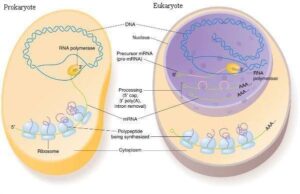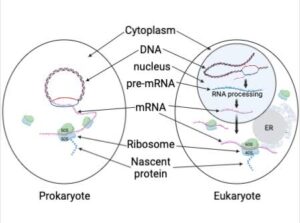Back to: MICROBIOLOGY 200 LEVEL
Welcome to class!
Hello amazing scholar! I’m always happy to welcome you back to class. You’re growing into a fine scientist, and today’s lesson is another step forward. We’re going to understand the comparison between prokaryotic and eukaryotic respiration. Whether you’re thinking about your own body or the tiny bacteria in yoghurt, respiration is what keeps cells alive and active. Let’s break it down together, the Afrilearn way!
Comparison Between Prokaryotic And Eukaryotic Respiration
What is Respiration Again?
Respiration is how living cells convert nutrients like glucose into energy (ATP). This process can be aerobic (with oxygen) or anaerobic (without oxygen). Both prokaryotic cells (like bacteria) and eukaryotic cells (like human, plant, and fungal cells) carry out respiration, but how they do it is slightly different.

Basic Differences Between Prokaryotes and Eukaryotes
Before we compare their respiration, remember:
Prokaryotic cells are small and simple, with no nucleus or membrane-bound organelles. Example: bacteria.
Eukaryotic cells are larger and more complex, with a nucleus and organelles like mitochondria. Examples: human cells, fungi, protozoa.
Now, Let’s Compare Their Respiration!
Location of Respiration
Prokaryotes: Since they don’t have mitochondria, all parts of respiration (glycolysis, Krebs cycle, and electron transport) happen in the cytoplasm and across the cell membrane.
Eukaryotes: Respiration is compartmentalised:
Glycolysis happens in the cytoplasm
Krebs cycle and Electron Transport Chain (ETC) happen in the mitochondria
Electron Transport Chain (ETC)
Prokaryotes: The ETC is embedded in the cell membrane
Eukaryotes: The ETC is located in the inner membrane of mitochondria
Proton Gradient
Prokaryotes: Protons are pumped across the cell membrane to the outside of the cell.
Eukaryotes: Protons are pumped from the mitochondrial matrix into the intermembrane space.
ATP Yield
Prokaryotes: Slightly higher ATP yield (up to 38 ATP) since they don’t use up energy transporting molecules into mitochondria.
Eukaryotes: Around 36 ATP per glucose because some energy is used to transport NADH into the mitochondria.
Flexibility
Prokaryotes: Can switch between aerobic and anaerobic respiration easily. Some bacteria even use nitrate, sulphate or carbon dioxide instead of oxygen.
Eukaryotes: Mostly use aerobic respiration, but some like yeast or muscle cells can do anaerobic respiration when oxygen is low.

Think of a roadside food seller (prokaryote) who uses a simple kerosene stove (cell membrane) to cook everything, right there in one open space. Now compare that to a fancy restaurant (eukaryote) with different rooms and sections (organelles) for each part of cooking. Both make food (ATP), but their setup is different.
Summary
- Prokaryotic respiration happens entirely in the cytoplasm and membrane.
- Eukaryotic respiration is more organised, with mitochondria playing a key role.
- Prokaryotes often produce more ATP because they don’t need to transport molecules into organelles.
- Prokaryotes are more adaptable, able to respire with or without oxygen.
Evaluation
- Where does the Electron Transport Chain occur in prokaryotic cells?
- Which cell type has mitochondria?
- Why do prokaryotes yield more ATP than eukaryotes?
- Give one example of an organism that uses anaerobic respiration.
Wow, you’ve done it again! You’re not just learning microbiology—you’re mastering how life works at the cellular level. Always remember: your mind is powerful, your future is bright, and Afrilearn is proud to be part of your journey. Keep shining, champ! See you in the next lesson.
